Traditional American clothing is more than fabric stitched into form—it’s a powerful symbol of cultural identity, shaped by centuries of history, migration, and resistance. From Native American Clothing regalia with symbolic beadwork to cowboy boots and denim jeans, each garment tells a deeper story. These clothes reveal how fashion was used to assert pride, adapt to new lands, or silently rebel against control.
Through pioneer clothing traditions and African American Clothing fashion history, we uncover styles born from survival and celebration. Even today, traditional outfits reflect the soul of a people. Understanding this fashion legacy helps preserve the cultural heritage American Clothing that continues to define America’s unique and evolving style.
Origins and History of Traditional American Clothing
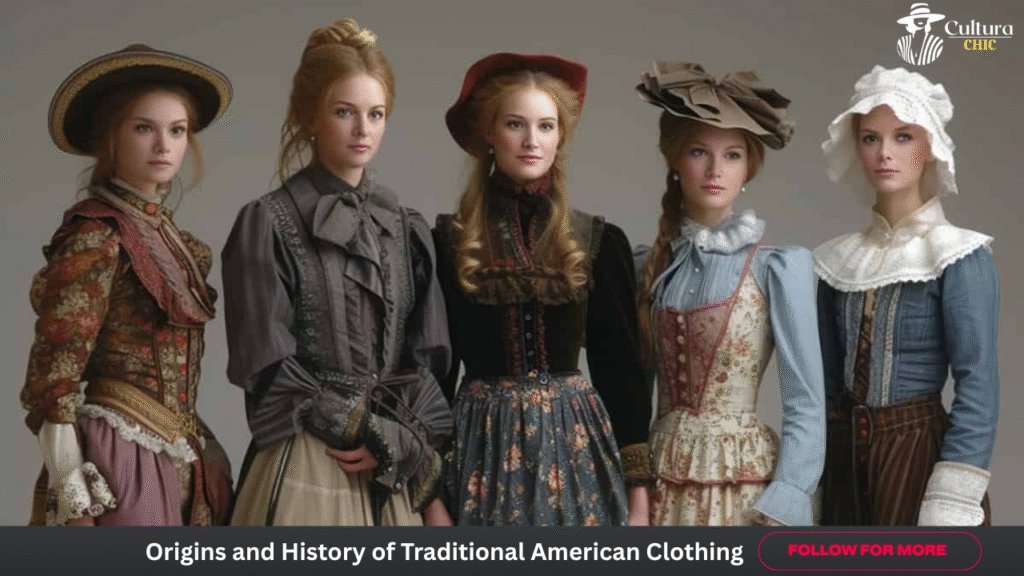
The beginning of Traditional American clothing goes back to the time before settlers arrived. Indigenous communities used natural materials for tribal clothing patterns and symbolic beadwork. Their designs carried spiritual meanings, tied to stories and ceremonies. As European settlers came, clothing evolved with the frontier’s needs. Outfits like buckskin jackets, prairie dresses, and bonnets came into use. These were not just clothes but tools for survival.
Later, different waves of immigrants brought their own cultural heritage clothing. These styles mixed with American fabrics and needs. By the 1800s, clothing also reflected class and religion. A sharp divide formed between formal wear and worker’s clothes. Yet through all changes, dress remained a clothing as identity marker in American history.
Traditional Clothing of the USA by Region
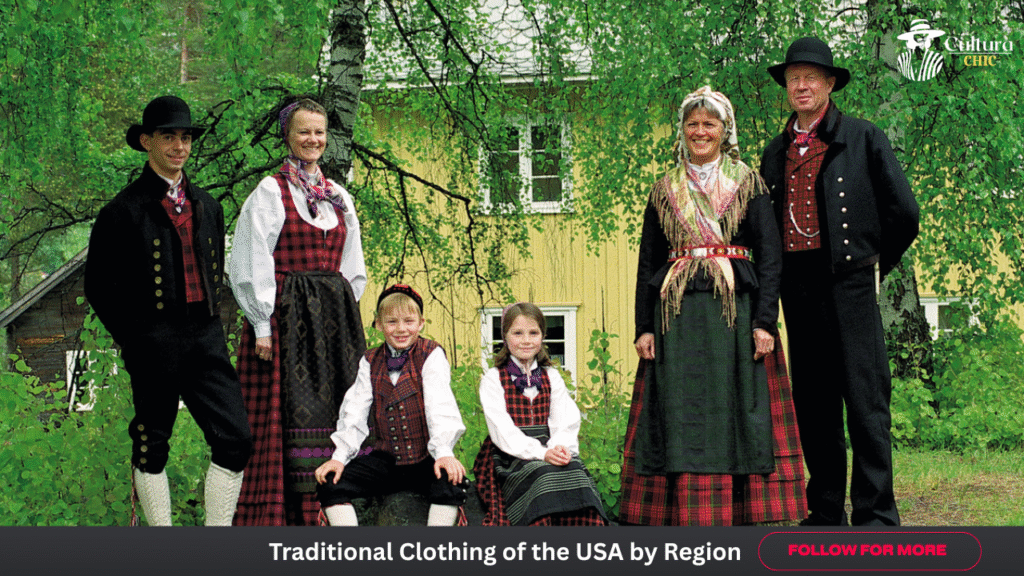
Each U.S. region has its own fashion roots. In the South, enslaved people used dress for secret messages. In the Midwest, pioneer clothing traditions like calico skirts and linen shirts were common. Western styles like cowboy boots and denim jeans blended Spanish and Native influences. The Northeast had Puritan wear, while the Pacific Northwest showed rich tribal clothing patterns of coastal Native groups.
Regional dress often reflects environment and economy. Logging clothes in the Northwest, cotton in the South, leather in the West. The result is a patchwork of traditions. Though many styles faded, they remain alive in modern memory, cultural events, and reenactments.
Clothing of Native American Tribes
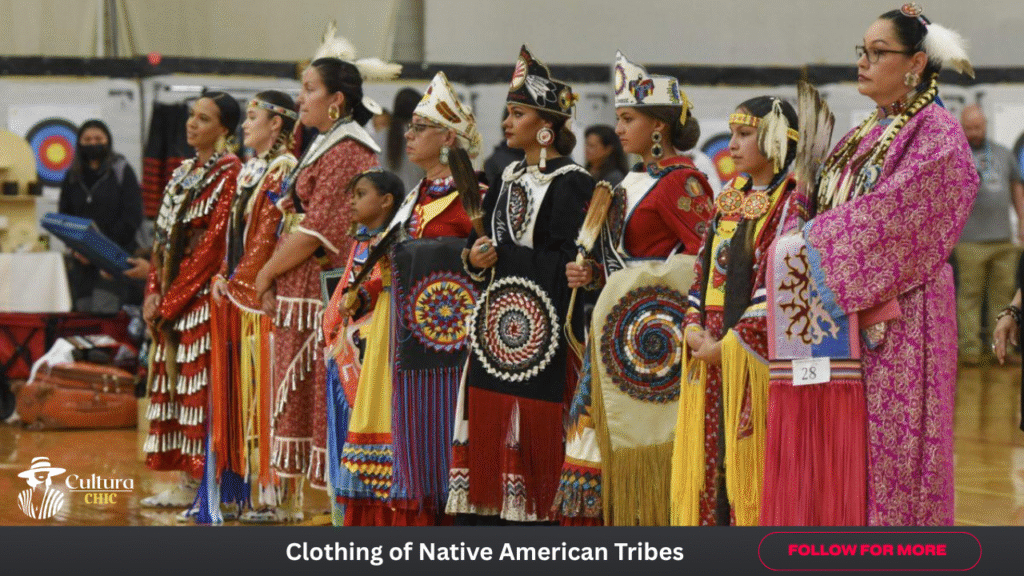
Native American regalia is not just clothing. It is a living tradition filled with symbolic beadwork and spiritual meaning. Each tribe has unique designs, materials, and messages. Deer hide, feathers, and shells tell stories of land and spirit. Powwows today show how ceremonial tribal regalia connects people to ancestry and ceremony.
But Native dress faced erasure. The boarding school system pushed military-style uniforms and banned traditional wear. Despite this, Indigenous fashion resistance grew. Tribes hid messages in patterns. Today, designers celebrate this past while blending old with new. Their art defies cultural suppression and celebrates survival.
Gender-Based Traditional Costumes
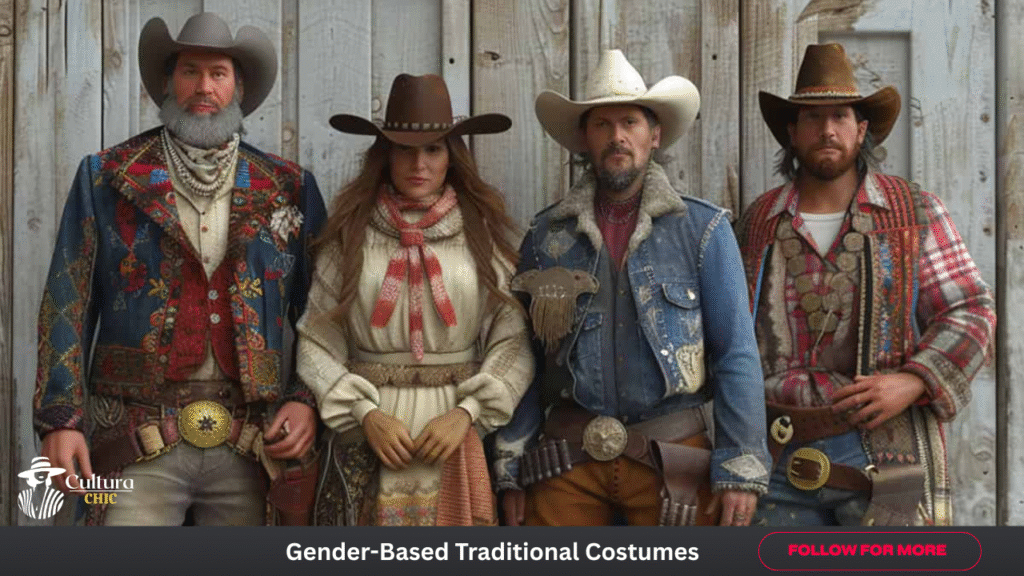
Early America had strict gender clothing rules. Women wore layered garments like corsets and crinoline, which limited movement. Men had functional clothes like leather vests and buckskins. These designs showed gender roles. Men worked in public, women stayed domestic. Clothing became a tool for women’s American Clothing control.
Over time, women resisted. The Dress Reform Movement challenged norms. Women started wearing trousers, facing laws against them. They aimed for comfort, health, and independence. Clothes became a sign of freedom or restriction. Even today, gendered styles carry past echoes.
Traditional American Clothing Through Eras
Fashion changed across American eras. In colonial times, people wore breeches and bonnets. The 1800s brought silk cravats, top hats, and hoop skirts. During the Civil War, mourning dresses and uniforms marked the times. By the 20th century, mass production shaped clothing identity.
Every era had its symbols. During the 1960s, hippie fashion protested war. In the 1970s, Native and Black pride reshaped public style. The Black Panther uniform became a symbol of strength. These looks were not just trends but statements of identity and protest.
Traditional Spanish Clothing: A Regional and Cultural Journey
Religion and Spiritual Influence on Clothing
Clothing often shows faith. Puritans wore simple black and white. Catholics used gold and rich robes. Native dress had spiritual ties, with feathers and sacred patterns. Religious dress protection laws now allow freedom for ceremonial clothes. Still, challenges remain.
Some Muslim women face headscarf bias in hiring. Laws now protect this. Yet students in some states still struggle for graduation regalia rights. Faith and fashion often intersect. And those intersections can bring both beauty and conflict.
Suppressed and Forgotten Styles in History
Many American clothing styles were once banned. Native children in boarding school assimilation programs had their clothes removed and hair cut. Women risked arrest for wearing pants under cross-dressing laws history. Immigrants faced ridicule for wearing traditional clothes.
But fashion returns. Now, students fight for cultural clothing laws. Designers revive what was once forbidden. The revival of banned clothing is not just about style. It’s about reclaiming identity and dignity, one stitch at a time.
Cultural Identity and Immigrant Traditions
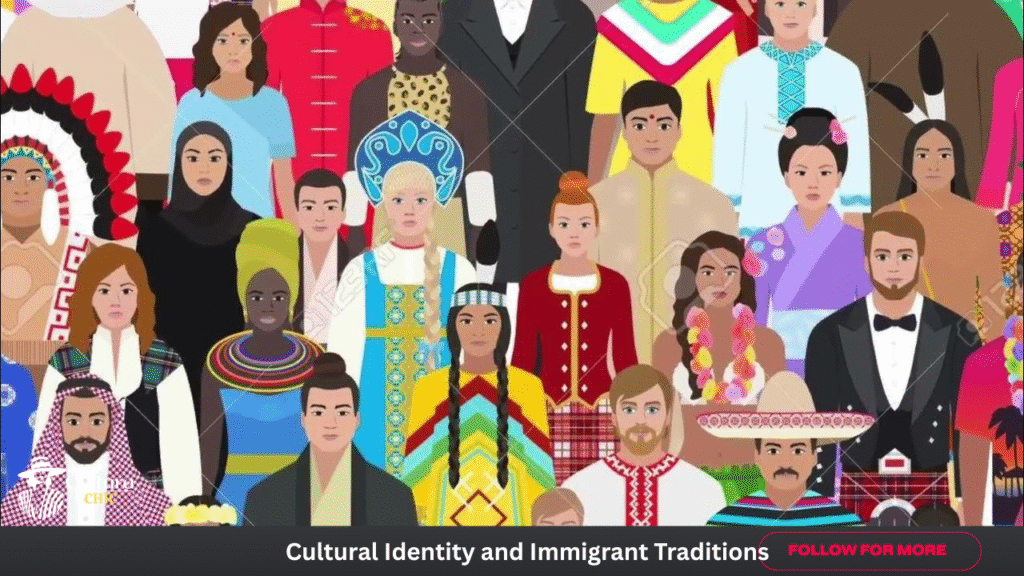
When immigrants came to America, they brought their cultural heritage American Clothing. At Ellis Island, many wore pieces from home. But they soon learned that dress could be dangerous. Many removed traditional clothes to avoid judgment. This became part of immigrant clothing adaptation.
In cities, immigrants joined the immigrant garment industry. They made clothes for Americans while hiding their own styles. The conflict of tradition and survival shaped generations. Even today, some hide family dress out of fear. Yet others proudly wear it to reconnect with roots.
Patterns, Fabrics, and Accessories in American Clothing
Clothing tells stories. Quilts passed secret signs using quilt code messages on the Underground Railroad. Red, black, and green colors honored African identity. Kente cloth symbolism showed family history. Beads, sashes, and embroidery passed on memory.
Here is a table showing fabric meanings:
| Fabric/Pattern | Cultural Use | Symbolism |
| Calico | Pioneer skirts | Frugality, labor |
| Buckskin | Native wear | Animal spirit, strength |
| Kente | African American attire | Royalty, resistance |
| Patchwork quilt | Underground Railroad | Hidden maps, messages |
| Denim | Western workwear | Strength, durability |
Accessories mattered too. Headwrap symbolism told stories in slavery. Bolo ties, moccasins, and bonnets showed region and culture. Dress was never just decoration. It carried family, faith, and future.
Traditional American Clothing Today
Today, tradition meets modern style. Powwows feature ceremonial tribal regalia with pride. Fashion weeks include Indigenous designers. African American creators explore dress as cultural pride. Traditions live on through fabric, runway, and ceremony.
Some schools still ban regalia at graduation. But Title VII protections and court cases change that. More Americans now see fashion as freedom. From protests to TikTok, tradition finds a new voice. Fashion as protest becomes part of daily life.
Conclusion
Traditional American clothing is more than cloth. It is memory, voice, and protest. It carries joy, pain, and power. From quilting Underground Railroad stories to dress reform movements, fashion has always spoken loudly.
Today, we celebrate the return of these clothes. We honor those who wore them in silence. And we fight to wear them proudly. Fashion may change, but its heart remains rooted in identity, pride, and resistance.
Traditional Colombian Clothing | A Colorful Expression of Culture and Identity
FAQs About Traditional American Clothing
Q: What is Traditional American clothing?
It is clothing from different groups that shaped America, like Native American Clothing regalia, pioneer clothing traditions, and immigrant styles.
Q: Who still wears it today?
People wear traditional clothes at powwows, festivals, and family events. Fashion designers also bring back traditional looks.
Q: Why were traditional clothes banned?
Due to forced assimilation, some clothes were seen as un-American. They were replaced by military-style uniforms or western suits.
Q: How did African Americans use clothing in history?
Through African American Clothing fashion history, clothes like quilts and headwrap symbolism showed strength and hidden messages.
What is the future of traditional clothing in the USA? People now fight for graduation regalia rights and share their heritage through style. The future blends traditional vs modern clothing.
Welcome to Cultura Chic! I’m CHAUDHARY ALI, an AI-Powered SEO, and Content Writer with 2 years of experience.
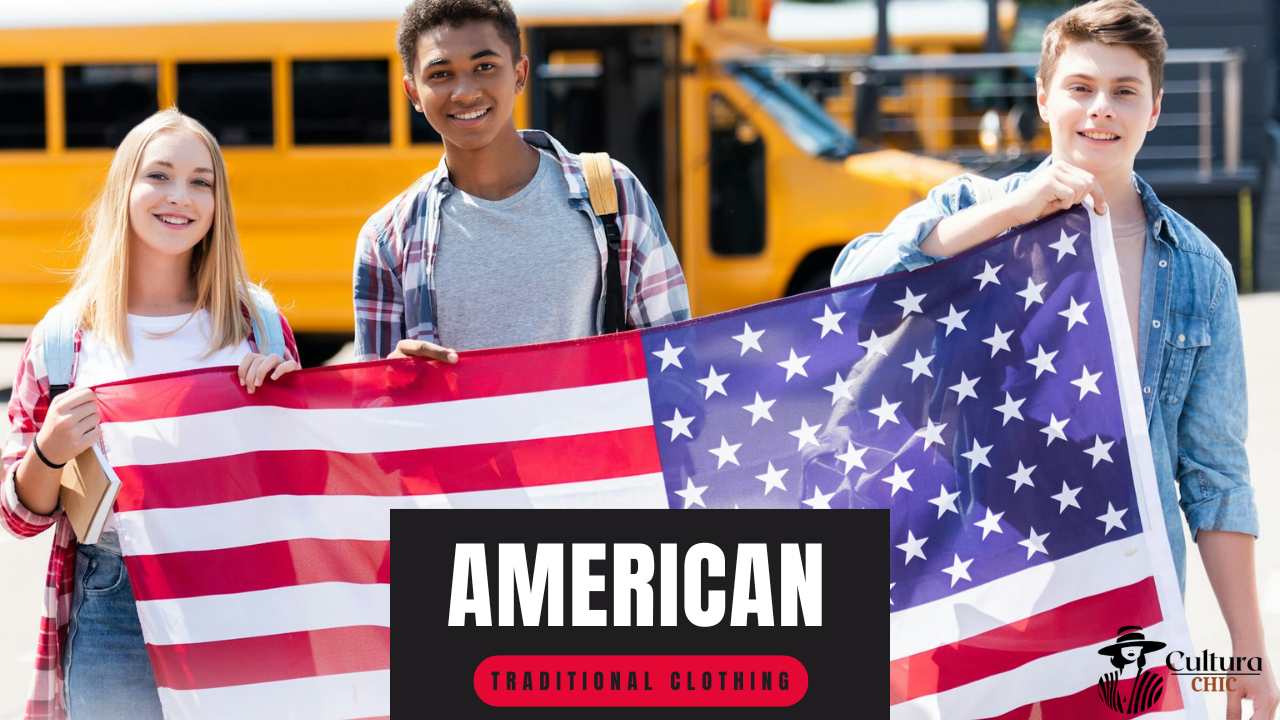
1 thought on “Traditional American Clothing”